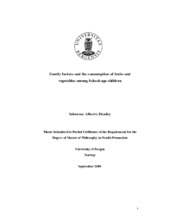Family factors and the consumption of fruits and vegetables among School-age children
Master thesis
Permanent lenke
https://hdl.handle.net/1956/7496Utgivelsesdato
2009-09-30Metadata
Vis full innførselSamlinger
Sammendrag
The consumption of fruits and vegetables are essential for the growth and development of children and this carries on into adulthood. However, fruit and vegetables consumption among children usually do not meet the national recommendations. There is therefore the need to improve the consumption of these food items among children. In order to design an effective intervention program to address this problem, there is the need to identify the factors that tend to influence these health behaviours. Various studies have been undertaken to establish the relationship between demographic factors and fruit and vegetable consumption. Others have studied the relationship between family factors and fruit and vegetable consumption among children. The present study explores the associations between several demographic and family factors, and fruit and vegetable consumption among children. The family factors examined include family structure, parents' emotional support, parents' academic support, family affluence and going hungry to school or bed. The Social Cognitive Theory was used as the theoretical framework with a focus on the environmental factors in the triadic reciprocity approach of the theory. The triadic reciprocity approach took into consideration the cognitive, affective and environmental factors having reciprocal effects on each other to produce behaviour. Secondary data, collected for the Health Behaviour in School-age Children (HBSC) study in 2001/2002 was used for the present study. The study had 5023 children consisting of 2554 boys and 2469 girls from both public and private schools. The age group distributions were 1660 11year olds, 1739 13year olds and 1624 15year olds. Various statistical analysis techniques including correlation and multiple regression analysis were used in the data analysis. All the variables, age, gender, family structure, parents' emotional support, parents' academic support, family affluence and going hungry to school or bed showed significant relationships with fruit consumption. The findings were similar for vegetable consumption except that family structure was not a significant predictor. Family factors appear to be significant predictors of fruits and vegetable consumption among children although the explained variance of these factors was quite small. Other factors such as accessibility and availability have been found to be influential. The use of other theories as well as a qualitative study is proposed for further studies to help explain the relationships better.
